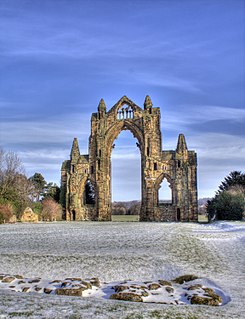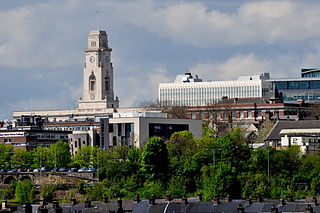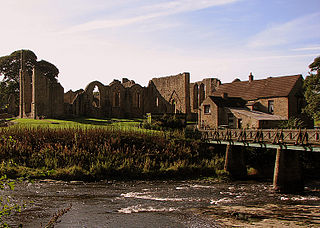
West Bretton is a village and civil parish in the City of Wakefield in West Yorkshire, England. It lies 7 miles (11 km) from Wakefield, 8 miles (13 km) from Barnsley, 9 miles (14 km) from Dewsbury, and 11 miles (18 km) from Huddersfield, close to junction 38 of the M1 motorway. It has a population of 546, reducing to 459 at the 2011 Census.

Gisborough Priory is a ruined Augustinian priory in Guisborough in the current borough of Redcar and Cleveland, North Yorkshire, England. It was founded in 1119 as the Priory of St Mary by the Norman feudal magnate Robert de Brus, also an ancestor of the Scottish king, Robert the Bruce. It became one of the richest monastic foundations in England with grants from the crown and bequests from de Brus, other nobles and gentry and local people of more modest means. Much of the Romanesque Norman priory was destroyed in a fire in 1289. It was rebuilt in the Gothic style on a grander scale over the following century. Its remains are regarded as among the finest surviving examples of early Gothic architecture in England.

Barnsley is a market town in South Yorkshire, England. As the main settlement of the Metropolitan Borough of Barnsley and the fourth largest settlement in South Yorkshire, the 2011 Census gave the town a population of 91,297 compared to the wider borough which had a population of 246,866. Historically in the West Riding of Yorkshire, it is located between the cities of Sheffield, Manchester, Wakefield, and Leeds. The larger towns of Rotherham, Huddersfield and Doncaster are nearby.

The River Dearne South Yorkshire, England flows roughly east for more than 30 kilometres (19 mi), from its source just inside West Yorkshire. It flows through Denby Dale, Clayton West, Darton, Barnsley, Darfield, Wath upon Dearne, Bolton on Dearne, Adwick upon Dearne and Mexborough to its confluence with the River Don at Denaby Main. Its main tributary is the River Dove, which joins it at Darfield. The river was one of those affected by the 2007 United Kingdom floods.

Grimethorpe is a large village in the metropolitan borough of Barnsley in South Yorkshire, England. Historically within the West Riding of Yorkshire, it had a population of 4,672 at the 2011 census. Grimethorpe is located to the east of Barnsley and south of Hemsworth; until the local government reorganisation of 1974, it was part of the Hemsworth district and constituency. At the 2011 Census the village was part of the North East ward of Barnsley MBC.

The Metropolitan Borough of Barnsley is a metropolitan borough in South Yorkshire, England; the main settlement is Barnsley and other notable towns include Penistone, Wombwell and Hoyland.

Royston is a suburban village within the Metropolitan borough of Barnsley, in South Yorkshire, England. Historically, the village formed part of the West Riding of Yorkshire, but was incorporated into the Metropolitan borough of Barnsley in 1974 and is now on the border with West Yorkshire. It is part of the Barnsley Central borough constituency, and has a population of 10,728. It is situated 4 miles (6.4 km) north-east of Barnsley, and 6 miles (9.7 km) south-east of Wakefield.

Lundwood is a village in Barnsley in South Yorkshire, England.

Monk Bretton is a village in the Metropolitan Borough of Barnsley in South Yorkshire, England. It lies approximately two miles north-east from Barnsley town centre.

Mount Grace Priory is a monastery in the parish of East Harlsey, North Yorkshire, England. Set in woodlands within the North York Moors National Park, it is represented today by the best preserved and most accessible ruins among the nine houses of the Carthusian Order, which existed in England in the Middle Ages and were known as charterhouses.

Finchale Priory sometimes referred to as Finchale Abbey was a 13th-century Benedictine priory. The remains are sited by the River Wear, four miles from Durham, England. It is a Grade I listed building.

Beauvale Priory was a Carthusian monastery in Beauvale, Nottinghamshire. It is a scheduled ancient monument.

Abdy is a hamlet in South Yorkshire, England. Abdy is located about 2 miles (3.2 km) west of Swinton.
Priory School and Sports College was a comprehensive secondary school in Barnsley, South Yorkshire, England. In September 2011 it merged with Willowgarth High School to form Shafton Advanced Learning Centre. It served the area including Lundwood, Monk Bretton, Cudworth and Cundy Cross.

Fishlake is a village and civil parish in the Metropolitan Borough of Doncaster. It was historically part of the West Riding of Yorkshire until 1974. In 2001 it had a population of 628, increasing to 682 at the 2011 Census. It was mentioned in the Domesday Book where the name is given as fiscelac, from Old English fisc-lacu, 'fish-stream'.

St Wilfrid's Church, Hickleton, is a parish church of the Church of England in Hickleton, near Doncaster in South Yorkshire.
There are 62 Grade I listed buildings in South Yorkshire, England. In the United Kingdom, the term listed building refers to a building or other structure officially designated as being of special architectural, historical or cultural significance; Grade I structures are those considered to be "buildings of exceptional interest". In England, the authority for listing under the Planning Act 1990 rests with Historic England, a non-departmental public body sponsored by the Department for Culture, Media and Sport.

Sir William de Notton, or Norton was an English landowner and judge, who had a highly successful career in both England and Ireland, culminating in his appointment as Lord Chief Justice of Ireland in 1361.

Hugh Benedict Willmott FSA MCIfA is a British archaeologist and academic. He is a Senior Lecturer in the Department of Archaeology at the University of Sheffield. His research focuses on medieval England, with a particular interest in monastic archaeology.
Monk Bretton is a ward in the metropolitan borough of Barnsley, South Yorkshire, England. The ward contains 14 listed buildings that are recorded in the National Heritage List for England. Of these, three are listed at Grade I, the highest of the three grades, and the others are at Grade II, the lowest grade. The ward contains the village of Monk Bretton and the surrounding area. In the ward are the remains of Monk Bretton Priory, its gatehouse and an administrative block, all, listed at Grade I. The other listed buildings are houses, farmhouses and farm buildings, a former water mill, a market cross, and a church.



















